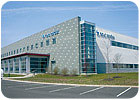
This facility was a complete retrofit (only the shell of the outside building remained), however, the facility was never occupied prior to this retrofit. Novo Nordisk required a single front-end, Web-based, graphical user interface (GUI) for the following building systems: Cleaver Brooks boilers, Trane Tracer chillers, Danfoss VFD pumps, Square-D Altivar VFDs, Semco energy recovery wheels, Phoenix Controls lab fume hoods (approximately 78 of them), ASCO's automatic transfer switches, and 50 Richards-Zeta VAVs.
Novo sought to use hardware and software to provide a complete, intelligent BAS and to provide advanced integration of the numerous disparate building systems. The building's system protocols include BACnet® IP, BACnet MSTP, LonWorks®, Modbus® IP, Modbus RTU, and several others. Novo required that the GUI use the existing Cisco IP network, allowing users to monitor, override, trend, schedule, and automatically log all information from either a high-level facilities view or a detailed system view. The company's administration chose Richards-Zeta and the RZ Mediator OMEGA to integrate multiple building systems.
Using RZ's Mediator and moZaic as the core integration hardware, and perfectHOST software as the graphical programming application, system integrator Open Systems Design (OSD), combined with Building Intelligence Group (BIG) (a division of Richards-Zeta), integrated all building systems into one open user interface. RZ's perfectHOST software uses complex algorithms converted to simple templates to create complex closed loop control applications, monitoring views, and to perform supervisory functions (overrides, schedules, trends, and alarms).
Using RZ's OMEGA embedded tool suite (WebExpress, WebScheduler, and WebSiteBuilder), OSD and BIG created a website that allows any user on the IP network, with approved security clearance, access to the building systems. Residing on the Novo corporate network and powered by Cisco Systems, the Mediator "normalizes" all disparate data from the multiple building systems and protocols, from the chillers to the lab fume hoods.
The OMEGA tool suite, which resides on the Mediator, an embedded Linux appliance with an integral python framework, has many technological advantages, including the ability to browse Web pages (via Asynchronous Java-Script and XML ~ AJAX) and gather information via XML-RPC. "From an IT perspective it is very nice to finally see the building systems converging, using real IT standards, on my network. The value of networking all of these systems is tremendous to the overall operations and maintenance of these facilities," said Bob Worrel, IT manager for Novo Nordisk.
The company's facility manager, Ted Bielicky, has also been extremely pleased to see the convergence of the building systems and IT systems occur in his building. "This use of advance networking technology for my building systems substantially improves the efficiency of my facility technicians by allowing full access anywhere on the Novo International corporate IP network," he said.
No additional workstations or infrastructure
The advantage for Novo was that the RZ solution did not require dedicated workstations or any additional network infrastructure beyond what was already planned for the facility, requiring only a standard Internet Web browser to interact with the new systems that came online. Integration, via the RZ Mediator OMEGA, into the existing Cisco VoIP telephony system and Cisco Call Manager, allowing complete access and manipulation to certain building systems data, is being contemplated as a next phase of work."We are now planning to add building systems (setpoints, certain overrides, schedules, energy usage, etc.) [to be] accessed via a services menu on the LCD browser on Cisco VoIP telephones furthering the value of the converged systems," Bielicky added.
